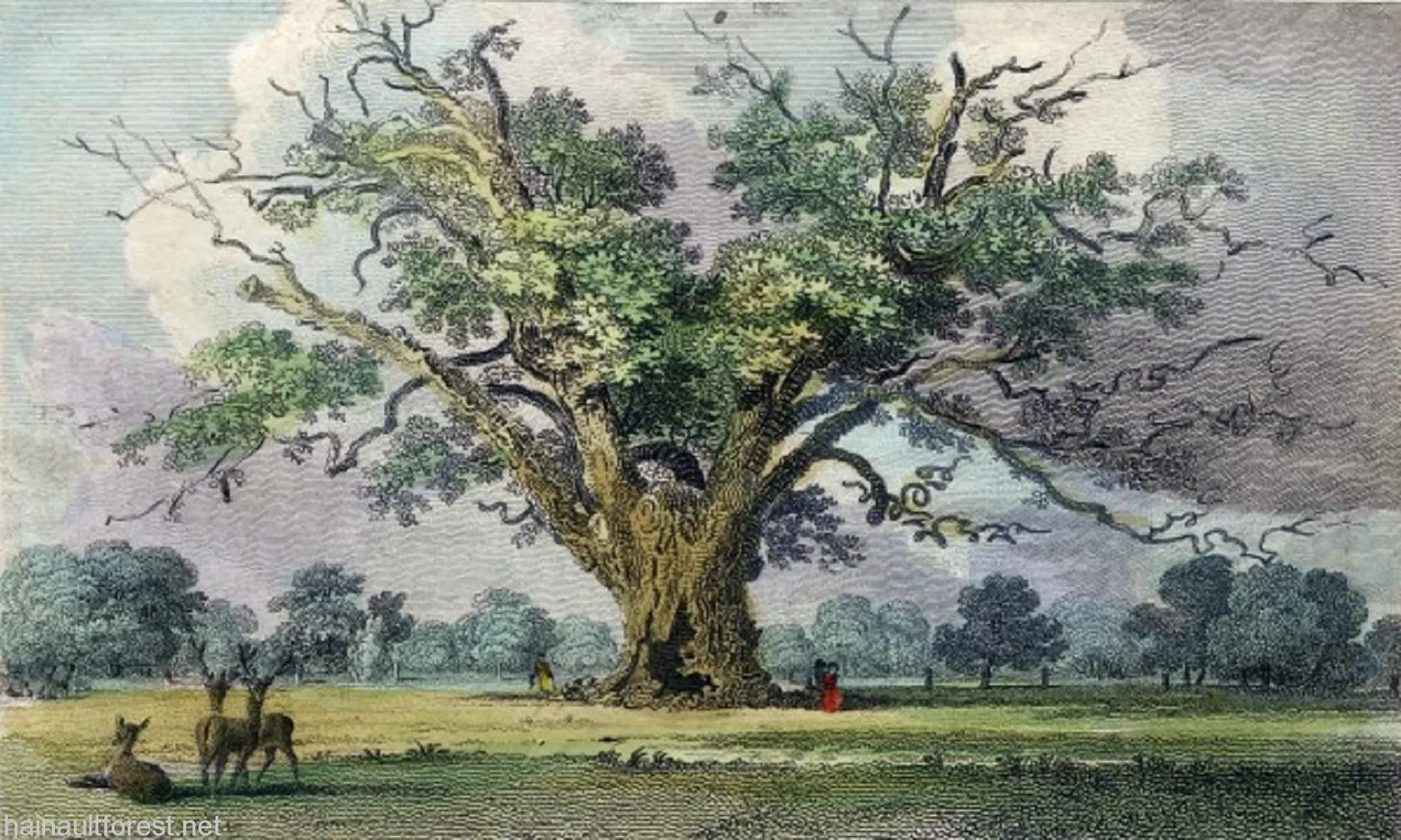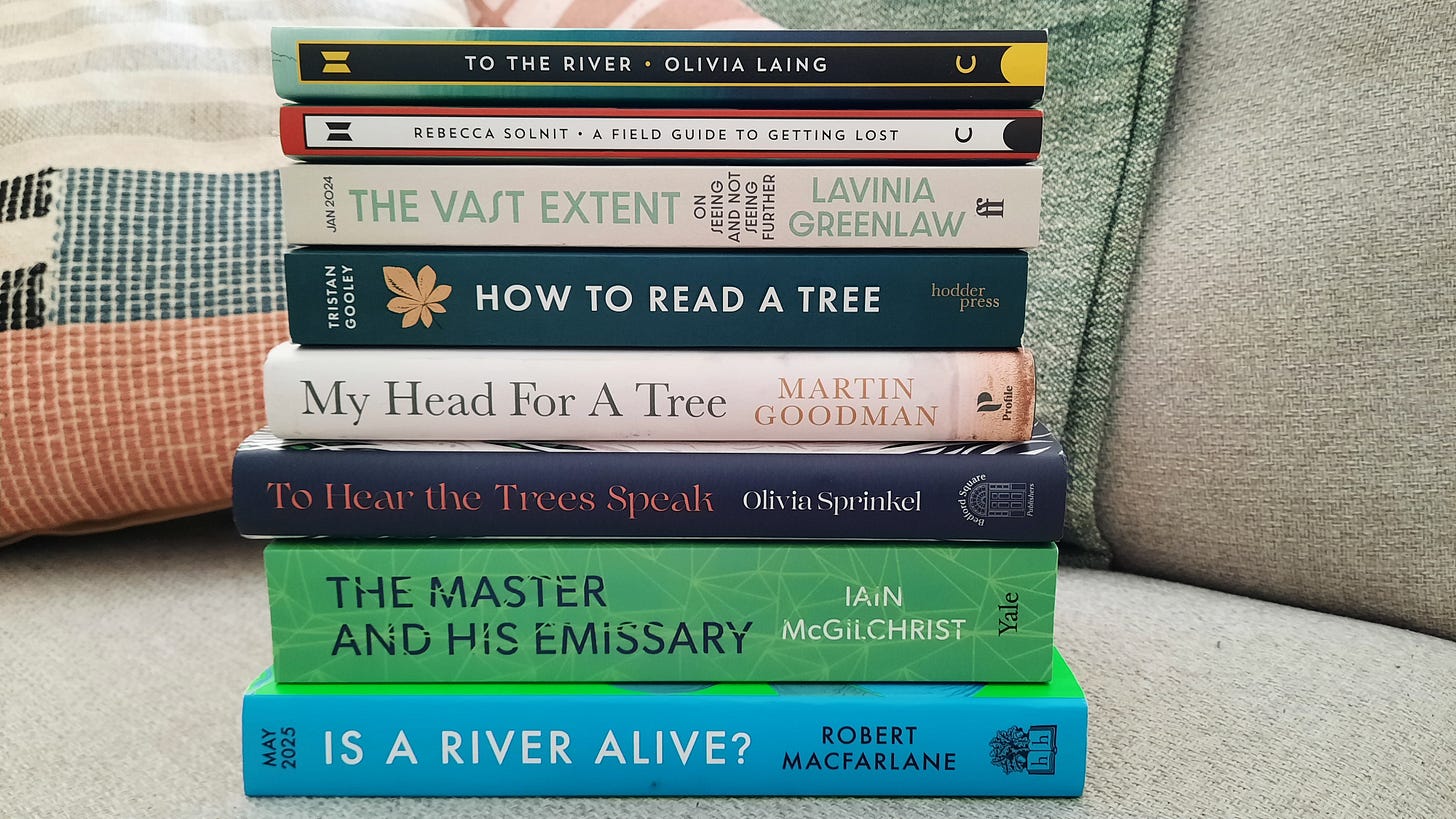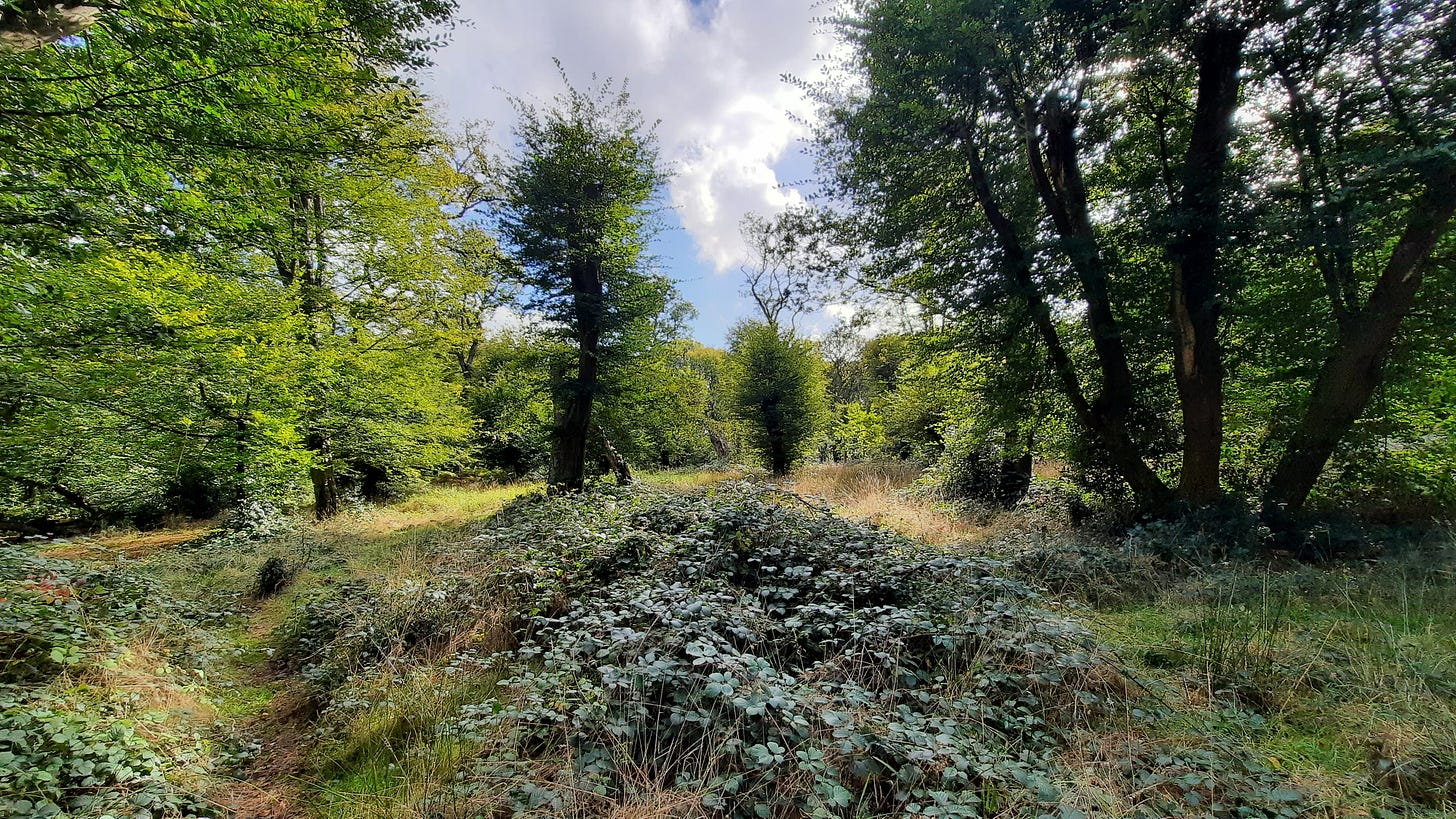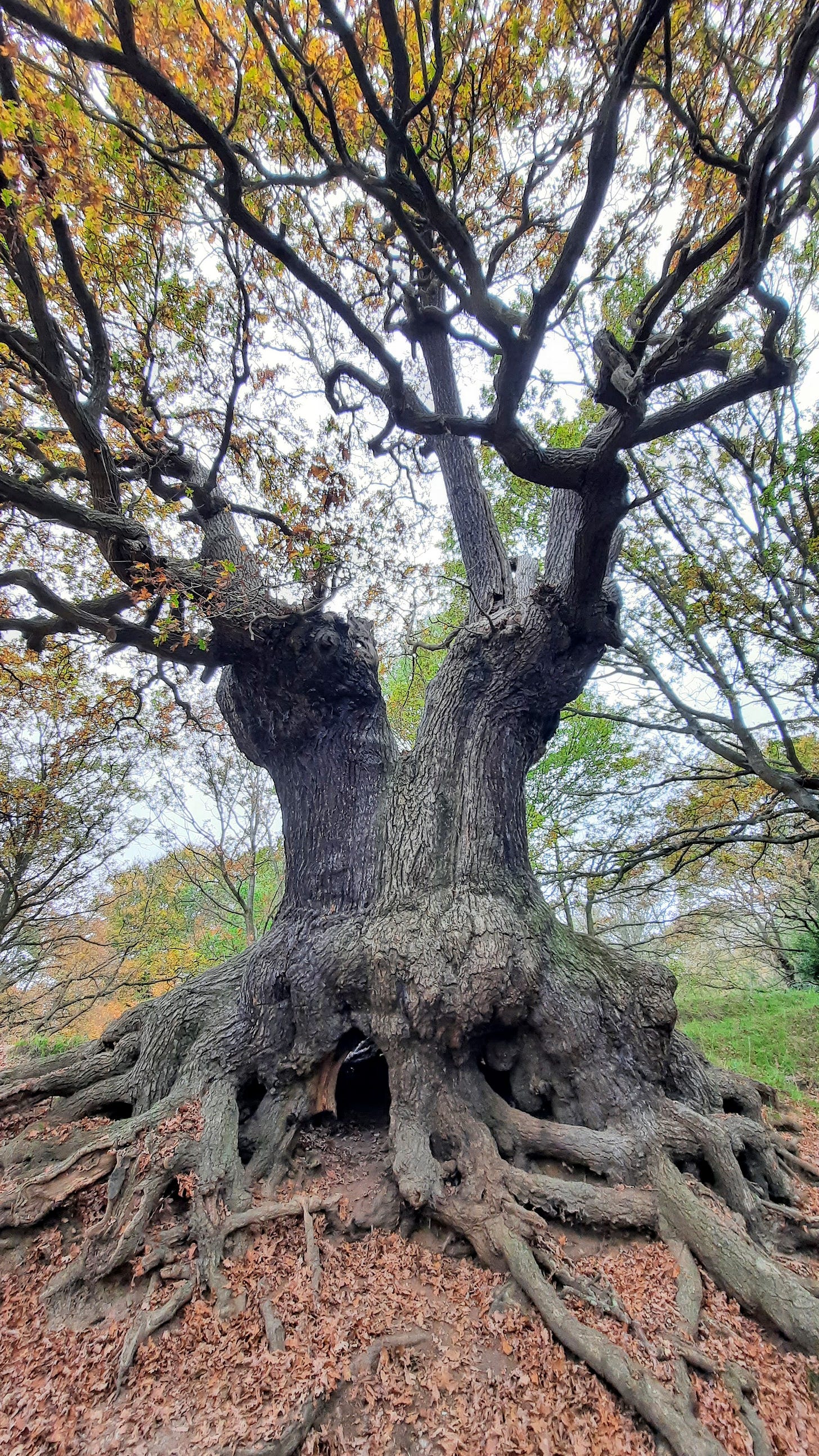A Tale of Two Forests
Thoughts on the commons, their theft and their defence, in four vignettes
This is a funny, hybridy sort of post. For weeks now I’ve been dreaming about sitting down to write a really meaty, well-researched Substack essay. Here are a few of the many books that I’m sure will give me all sorts of ideas when I finally get round to reading (or rereading) them:
But, you know. Life. I recently finished a second draft of my second novel, and now I have notes from my agent for further revisions. Before I make said revisions, however, I need to make some headway with my third novel, a commission that I’m writing under a pen name (wild, I know—I’m as surprised as you) and that I’ve said I’ll hand in by Christmas. I’ve got some freelance editorial work on at the moment too, plus a part-time job in a bookshop and a singing side hustle that’s come as even more of a surprise than the novel commission. So I am quite busy. Meaty Substack essays might be the thing I want to write most of all, but they also feel like the thing I can least justify devoting my time to right now.
But then, when I started work on ‘Things to Pay Attention to In July’, my monthly post for paid subscribers and the one Substack thread I’ve been clinging to of late, I found that there isn’t a huge amount going on in July, apart from Wimbledon. Meanwhile—having turned for inspiration to Steve Roud’s The English Year, a treasure trove of niche historical titbits that I consult every time I write a post in this series—I learned about a very special tree. Knowledge of this tree completely derailed all the plans I had for the post in question. I decided to go with the flow, and ended up putting all other projects on hold to write an essay after all. Funny the way ideas come in through the back door sometimes.
Yesterday I learned about the Fairlop Oak, a mind-bogglingly enormous tree that stood for centuries on the edge of Hainault Forest, Essex, a few miles east of where I live. Once upon a time it was the focal point of the Fairlop Fair, an annual gathering on the first Friday in July. Why this tree drew people to it is no mystery, if this description is accurate:
the trunk measured over 20 metres in girth and 6.7 metres in diameter and had a hollow recess where six or seven cattle would seek shelter on hot days. Most of the 17 branches measured at least 3.6 metres in girth. With the sun at its highest the shadow cast covered ground about the size of 2 football pitches. The tree was reckoned to be over 1,800 years old.

If it really was that old, it would have been planted at around the time Jesus was born.
The tree no longer stands. It caught fire in 1805 and was eventually blown down in 1820. One of my favourite questions to ponder is when and where I would time travel, given the opportunity, and I think this oak tree has overtaken the post-Roman ruins of London to the number one spot. In the meantime, while I await the invention of time tourism, I could go to St Pancras church in central London, where the pulpit and reading desk are made of wood from the fallen oak, or I could make a pilgrimage to the site where the tree once stood, in Hainault Forest itself.
The idea has me thinking: why have I never been to Hainault Forest? It’s only a few miles from my front door and easily accessible on public transport. But a quick glance at Google maps reminds me of the answer. Hainault Forest is a mere pocket handkerchief compared to nearby Epping, a majestic and ancient expanse of woodland and one of my favourite places in the whole world. If I’m in need of a tree fix, Epping Forest is inevitably my first choice.
I suspect, also, that there there is a sorry tale behind Hainault’s diminutive size. I’m not wrong, as it turns out.
Once upon a time, the forests of Hainault and Epping were ‘sister forests’. I’m not sure if they ever fully joined up with each other, but the stretch of land separating them was once very small. Both were managed as common land, which meant local commoners had the right to forage, collect firewood, let their pigs feed on acorns and beechmast, and to graze cattle. They also had the right to pollard the trees (a form of pruning) so that light could penetrate the canopy, enabling the growth of grass and other vegetation for the cattle to feed on. This symbiotic relationship between the land and the people who worked it shaped the evolution of the forests’ ecosystems, and is part of the reason why so many ancient trees survive in Epping Forest today.
Hainault Forest was owned by a local nunnery, Barking Abbey, until the dissolution of the monasteries in the mid-sixteenth century, at which point its 3,000 acres of woodland passed into Crown ownership. And three hundred years later, the Crown allowed it to be enclosed and eradicated. The Fairlop Oak turned out to have been a bellwether for the forest as a whole. Thirty years after it fell, the Hainault Forest Act of 1851 sealed the fate of the rest of the land:
Her Majesty, in right of Her Crown, is … to be seised to Herself … of the Soil of … of the said Forest of Hainault …, and of the Timber and other Trees, Bushes, and Underwood standing and growing thereon … Her Majesty has been graciously pleased to signify Her Consent that the said Forest of Hainault should be disafforested … with all convenient Speed.
Following this Act, the trees of Hainault Forest were felled. Around 95% of it was turned into farmland, and later built on. Today, at 334 acres, it is just over a tenth of its original size. A sorry tale indeed.
But! It is also an inspiring one, because local people were so disgusted about the destruction of their forest that they fought tooth and nail to prevent the same thing happening to Epping. By the time of the Hainault Forest Act, a third of Epping Forest had already been enclosed and privatised by landowners. Fragmented ownership made this a trickier task than with Hainault, but nevertheless, the writing seemed to be on the wall. By 1870, only around half of Epping Forest remained freely accessible.
In 1871, 30,000 East Londoners gathered on Wanstead Flats, at the forest’s southernmost tip, and tore down the enclosing fences that had been erected there. At this point, the City of London Corporation stepped in. (Don’t be fooled by the word ‘corporation’—they are good guys in this tale.) The Corporation owned land within the Forest’s jurisdiction, which technically gave them commoners’ grazing and foraging rights. It sued the landowners for infringing these ancient rights, and in 1874, a judge ruled that all the enclosures that had happened since 1851 were illegal. Shortly after this, an act of Parliament allowed the Corporation to buy the forest and manage it for the people, vowing that
the Conservators shall at all times keep Epping Forest uninclosed and unbuilt on, as an open space for the recreation and enjoyment of the public … [and] shall not sell, demise, or otherwise alienate any part of the Forest … [and] shall at all times and as far as possible preserve the natural aspect of the Forest.
And so it remains today. With climate change, air pollution and ongoing development at its fringes, it would be naïve to presume that Epping Forest is fully out of danger. But the original Act of Parliament still protects it from being carved up and sold off, and keeps it open and accessible to the public. I am stupendously grateful for its existence. I go there frequently, and I always leave feeling better than when I arrived. For that, I am indebted to the historic anger of ordinary East Londoners.
Once you start looking, you discover an awful lot of historic anger about these kinds of land-grabs by the powerful. This past weekend, I went to a street party in my neighbourhood put on by my local folk club. Traditional music is the artistic equivalent of common land: publicly-owned, communal, there for everyone. Presumably much of it originated on common land too, composed—whether collectively or individually—by people working this land in the days before their right to do so was rescinded.
So there is something particularly pleasing, I think, about folk music that addresses the question of the commons, and of their theft from the many by the few. One of the songs I heard at the street party was called ‘The Goose and the Common’, an anonymous 18th-century poem that has been set to music many times. The words, a pithy summary the injustice of enclosure, are disappointingly apt for our times:
They hang the man and flog the woman
Who steals the goose from off the common
But leave the greater villain loose
Who steals the common from off the goose.
The law demands that we atone
When we take things we do not own
But leaves the lords and ladies fine
Who take things that are yours and mine.
The version I heard at the street party was sung to a tune by The Wilderness Yet. Here they are performing it. It’s SO good—the anti-capitalist anthem we all need. I urge you to listen.
It’s funny, the way related ideas and issues emerge in quick succession from seemingly unrelated places. Recently I happened to butt up against another situation that felt like a legacy of enclosure, completely independently of my discoveries of the Fairlop Oak and ‘The Goose and the Common’. I had a notion that I ought to get an allotment and start growing vegetables, so I emailed my local allotment management committee to express my interest. I knew there would be a waiting list, that it wouldn’t be an instantaneous process. I didn’t expect to be told that demand was so high that the waiting list was closed and expected to remain so for at least three years.
I laughed this off as a sign from the universe that I ought to tend to the ailing plants on my balcony before taking on a big horticultural project for which I most definitely do not have time. But then I learned a fact that cast the shortage of allotment plots in a new light. According to Guy Shrubsole’s Who Owns England? blog, ten times more land in England is allocated to golf courses than it is to allotments.
Allotments are in high demand in my area because gardens are small or non-existent. Increasing numbers of people live in flats, as I do. Some inhabitants of such flats are social housing tenants, who own no property at all; others, like my partner and me, own their home, or at least a small portion of it. The English1 leasehold system, however, means that owning a flat does not entitle you to any share in the land on which it stands. Someone else owns the walls that surround us and the ground beneath our feet.
Allotments, then, like the commons before them, are gateways by which the landless can access land. Not just access it: steward it, nurture it, work with it, and enjoy the fruits of these labours. Most allotment sites are owned by local authorities or charities and do not turn a profit. It costs between £40 and £80 per year to rent an allotment at one of my local sites.
By contrast, it is nearly £500 per year to join my nearest golf club. Golf courses are usually to be found in leafier suburban and rural areas, where the landed live. They serve no purpose except to keep golfers—typically rich, white, male elites—entertained. Often they are enclosed and the general public are not permitted access.
Of course, we won’t solve the problem by simply swapping out golf courses for allotments—it’s more complicated than that. But the embarrassment of golf courses in this country is indicative of deeper underlying priorities. There are 310,000 acres of golf courses in Britain, enough to cover an area the size of Greater Manchester. That is more than the amount of land devoted to public parks. In the affluent and notoriously conservative county of Surrey, there is more land devoted to golf courses than to housing. A country that apportions this much land to the Sunday afternoon leisure pursuits of rich men, drenching it in pesticides in the process, all while access to nature for the poorest in society remains disgracefully restricted, is one that has ceased to question the idea that land is primarily for the rich to use in whatever way best serves their interests.2
All of these chance discoveries—the Fairlop Oak, ‘The Goose and the Common’, the allotment waiting list—seem to be pointing my efforts and attention towards a pressing issue that fills me with horror and which I would rather much rather pretend wasn’t happening.
Last month, I read a terrifying Substack piece by
about a quiet decision by the Trump administration to put 3 million acres of US public lands up for sale, with up to 40% of all federally-owned lands to follow. The bill, Pattiz writes, ‘would trigger the largest loss of public land in modern history’. Forests, wildlife corridors, sacred indigenous sites, carbon sinks, drinking water and public access to the land are all on the line. The beneficiaries of the bill will be property developers, mining companies, fossil fuel companies. Probably golf clubs too, knowing Trump.These lands are an ocean away from me, but we’re all connected. Leaving aside the sickening arrogance and audacity of it, we know enough about climate change to know that the loss of ecosystems anywhere is of concern to everyone, everywhere. So the struggle to save them will be my struggle too.
Besides, the parallel between British and American land theft was drawn long ago. The brilliant Eula Biss, writing in the New Yorker in 2022, cites an eighteenth-century advocate of enclosure in Britain, who argued that:
‘Leaving the commons to the commoners … would be like leaving North America to the Native Americans. It would be a waste, he meant. Imagine, he suggested, allowing the natives to exercise their ancient rights and to continue to occupy the land—they would do nothing more with it than what they were already doing, and they would not “improve” it. Improvement meant turning the land to profit.’
Nowadays we can see with our own eyes the damage and danger caused by the centuries-long drive towards ‘improvement’—by the belief that our lands are nothing more than an exploitable resource. If American lands had been left to their indigenous populations, and if British lands had been left to the commoners, we would not be in the predicament we are in today. But the powerful still persist in this destructive belief, imperilling us all.
If anyone in America who is engaged with this issue (hello
, hello ) knows of ways for non-Americans to help in the coming battle to protect America’s public lands, please do share them in the comments.There will be many more Hainault Forests in the future. It seems like a fantasy, right now, to suggest otherwise. But if we are angry enough, and vocal enough, perhaps there will be many more Epping Forests too.
That’s English as distinct from British—Scotland has abolished this system.
This is why few things make my heart sing more than news of golf courses being rewilded and made accessible to the public.






Thank you for this Kate. I think the proposal to sell public land here in the US failed, for now (although a whole bunch of other stuff didn't, ugh, aack, expletives). The history of the forests there is so interesting. I thought of the poet John Clare and how the Enclosure Acts influenced his life and work.
Thank you so much for writing this, Kate. It's all incredibly important and, as you eloquently point out, connected. The fight for public lands in the U.S. is absolutely related to enclosures of the commons over the centuries in Britain. And it's a fight that will never end. There is a lot of strong advocacy here fighting for their protection from privatization--very strong groups and voices --but I think probably the most important act many of us can do is exactly what you're doing here: find as many ways as possible to reawaken as many people as possible to the outlandishness of land as private property, to the deep history we all have with land relationship, and what it means for our freedom, much less the freedom of the rest of life, to lose it.
Thank you for the work you do!